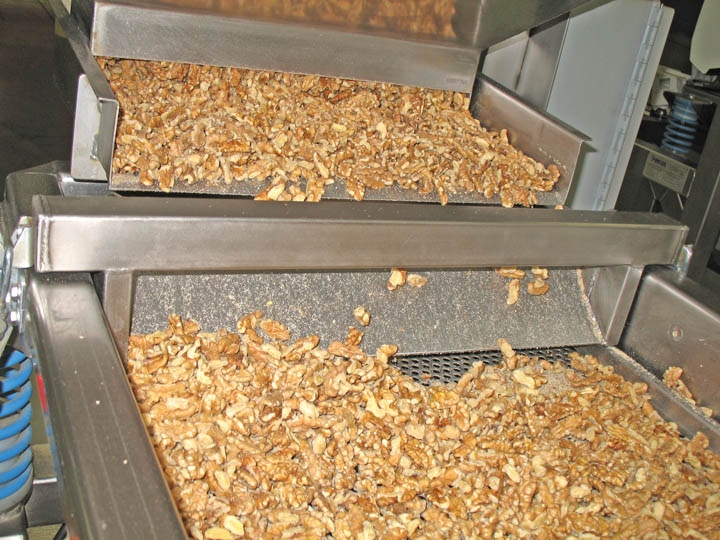
Results of two walnut field trials conducted by University of California researchers over an 11-year period question the conventional wisdom that pruning prevents tree growth from stalling out.
The research was conducted by Bruce Lampinen, Extension specialist, UC Davis; Janine Hasey, farm advisor for Sutter/ Yuba/Colusa Counties and Carolyn DeBuse, former orchard systems advisor, for Yolo/Solano Counties. They describe the studies in the Winter 2014 issue of Walnut News, the California Walnut Board’s industry newsletter.
Traditionally growers train young walnut trees by removing about a third of the previous year’s growth on scaffold limbs. The researchers studied the effect of pruning versus non-pruning on walnut tree growth and productivity.
The first trial, involving Howard walnuts, began in 2004 during the dormant season prior to the third growing season. In the first two years of the orchard’s life before the trial, the trees were pruned using standard practices and scaffolds were selected. Coming into the third season in the pruned plots, the researchers removed about one-third of the prior years’ growth on all branches that had grown the previous year. On the unpruned treatment trees, they removed only branches that were likely to hinder travel through the orchard or impair visibility of the trunk for shaking.
More from WFP
Obama administration misses boat on drought assistance
Big Data is agriculture’s big blank on the map
Lack of leadership makes drought worse
The pruning treatments were continued during the dormant season from 2004 to 2010. In the first and second year after treatments started, yields in the unpruned treatment trees tended to increase slightly. However, after seven years of treatments, the researchers found no significant differences in tree growth (as measured by trunk circumference or midday canopy light interception), cumulative nut yield, or nut quality between the pruned and unpruned treatments.
To determine the impact of crop load on tree growth, all nuts were removed from both pruned and unpruned trees when the nuts were about one-quarter inch in diameter in the third, fourth and fifth growing seasons. This resulted in a slight but insignificant increase in tree growth. Meanwhile, cumulative yields over the seven years of the study decreased. “This suggests that cropping is not causing trees to stall out in growth,” the researchers note.
Pruning trial
In 2009, they began a second training and pruning trial on a one-year-old Chandler planting. This time, the researchers looked at three pruning treatments, which began after the first growing season.
One group of trees was left unpruned. One leader was selected and any others were removed if there was more than one leader that grew during the first year. After that, only branches lower than about four feet were removed if they were likely to cause a problem for tractor traffic or shaker visibility.
The second group received minimal pruning, a long-standing University of California recommendation. After the first growing season, the trees were headed at about 6 feet. (This is the heading height for a hedgerow orchard. In standard spaced orchards, the researchers note, trees would be headed at 7 to 8 feet.) In the following years, about one-third of the previous growth on branches that were slated to become major scaffolds (four to six per tree) were cut back. The other branches were left unpruned.
The third treatment involved heavy pruning, a practiced followed by some growers. After the first growing seasons, the trees were headed back at about 6 feet. In the dormant season preceding the third growing seasons, one-third of the previous years’ growth was removed from four to six scaffolds. Any branches that were competing with the main scaffolds were removed as well. One-third of the previous years’ growth was removed from all the remaining branches. Also, all in-season branching points were reduced to a single branch and branches below 3 to 4 feet were removed.
After the fourth growing season, the researchers found no significant differences in nut quality or cumulative yield for the unpruned or minimal pruned treatments. However, cumulative yield for the heavily pruned treatment was significantly less than either the unpruned or minimal pruned treatments.
“When the costs of pruning and disposing are also included, heavy pruning is not an economic option,” say the researcher.
The results of the two trials don’t support the commonly held idea that walnut trees need to be pruned in order to keep them growing or to produce adequate yields, they report. The perception that walnut trees need to be pruned to keep them growing, the researchers note, might be related something they observed in these trials.
“Walnut trees tend to put on extension growth on individual shoots in alternate years.” they explain. “The year following elongation, the shoot only produces a short (5- to 8-inch) increment of growth on the end and side branching occurs on the shoot. Each individual shoot tends to follow this pattern of extension growth followed by cross branching followed by another season of extension growth. Pruning can short circuit this process and force multiple years of shoot elongation but this comes at the cost of early production.”
The results of these trials suggests that heavily pruned trees are much more prone to breakage when pruning is decreased, the researchers add. Cropping occurs on these branches that have not had much crop. As a result, they are relatively weak and tend to break.
They recommend interested growers try the unpruned method in small blocks or a few rows for comparison to the minimal pruning method to make sure it fits their management system.
Currently, trials are underway in Butte, Merced and Tulare Counties to assess the impacts of pruning versus non-pruning under different climatic and soil conditions and management practices.
More from WFP
Obama administration misses boat on drought assistance
About the Author(s)
You May Also Like




